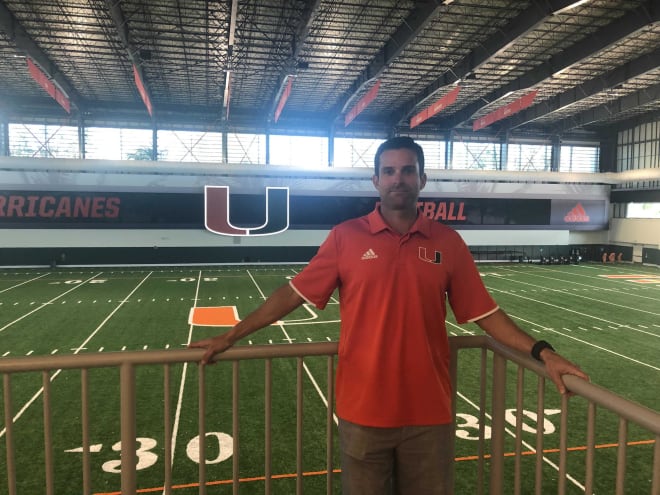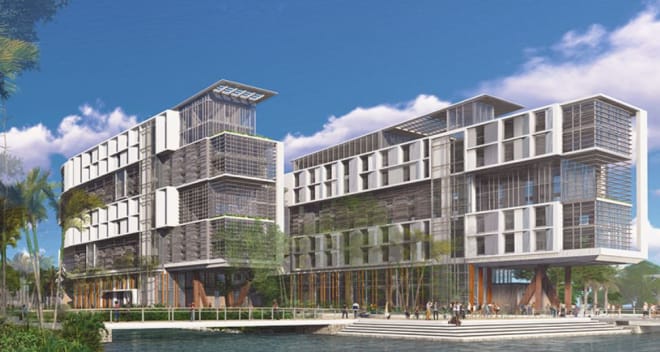STATE OF THE U 2020: Facilities analysis

STATE OF THE U: Biggest on-field question
STATE OF THE U: 2021 class analysis
STATE OF THE U: 2020 class analysis
STATE OF THE U: 2019 class analysis
STATE OF THE U: 2018 class analysis
STATE OF THE U: 2017 class analysis
STATE OF THE U: 2016 class analysis
OPINION: Diaz attacked problems and State of the U should benefit
STATE OF THE U: Where does program stand in college football landscape?
The 83,000 square foot Carol Soffer Indoor Practice Facility, replete with 80- and 40-yard turf fields and a state-of-the-art weight room and locker room.
New student dorms (called the "Student Housing Village") overlooking the lake in the middle of campus, where some athletes could be housed.
An upgraded Schwartz Center that displays the Canes' championship and bowl trophies almost as soon as you walk in the door.
A top-of-the line training table where players can gorge on everything from steak and chicken to sandwiches, fruit and everything in between.
The general allure of a palm tree-shaded campus.
Miami virtually has all the amenities a top college student-athlete could want.
And there was a lot of time and money the Canes have put into the campus for those student-athletes. With football the main attraction, we took a deeper dive into just how much recruits actually pay attention to this stuff.
As it turns out, that depends on the recruit.
A sample:
Cane OL commitment Michael McLaughlin says "The new facilities definitely played a role in my commitment. If I’m going to be somewhere for four years, I want it to be somewhere where I can be comfortable and enjoy where I am at. The new dorms are top notch, and the weight room and indoor facility will really come into play and be useful on those rainy and stormy days so we can move practice inside and still be able to get work in."
Another commit, PK Andres Borregales, offered that "It kind of played a part because it's one of the nicest facilities I've seen."
On the other end of the spectrum?
CB commit Malik Curtis says he chose UM because of the football team itself and the coaches, not the facilities. In fact, he committed without even touring the campus.
"I wasn't able to get down to Miami any time before the commit due to camps and track season," he says.
Then there are those in between, which is where it seems most recruits fall. Several prospects we spoke to said good facilities are a plus ... but not something that would make or break a program's chances. That's assuming the facilities are the basics a player needs to succeed; awful facilities would of course be a negative mark against that program.
Perhaps DT commitment Allan Haye put it most succinctly when he told CaneSport that "It (facilities) didn’t really play a role - all these colleges all have got nice facilities and things of that nature. What separate a school from another for me is the brotherhood and how comfortable you are with the coach and the defense and the role that you’ll be expected to fill."
Elijah Arroyo, a TE commitment out of Texas, said that "The dorms played a little bit of a role as far as making a decision, but the rest of the facilities were not really a factor."
The take of RB Thaddius Franklin, who is a soft commitment and plans to take all five of his visits in the fall?
He says the facilities rank "third most important" on his list of factors.
"I'm looking at school-wise, then football-wise, then the facilities," Franklin says. "So yes, I’ll be looking at the facilities as I take visits."
So far how do UM's facilities stack up with those of other programs he's seen?
"They're fine," Franklin said. "But they are smaller than some other places I've been like Penn State, South Carolina and Pittsburgh. Those aren't nicer, they're just bigger. There's nothing wrong with Miami's facilities."
We also reached out to one of last year's signees, Quentin Williams, for his take - Williams is one of the freshmen set to report July 1.
"For me it was a plus, but that didn't really play a role in my decision," Williams said. "Miami was my favorite schools since I was a kid, so that was the biggest thing. But the facilities are nice, and I saw the rooms athletes can stay in while they were under construction - there's a big living room between both rooms, a washer and dryer, separate showers and everything."
Another perspective, from an undecided recruit UM is chasing: "I mean, to be honest, it's a benefit to have good facilities, but it really doesn't matter to me because I'm going to put the work in," White Castle (La.) University Laboratory School S Jardin Gilbert says. "It's not about facilities, it's about putting work in and being comfortable in the school's environment."
Gilbert got a virtual tour of the facilities during the coronavirus shutdown and says "I love the new dorms, they're brand new and if I decide to go there they wouldn't even be finished with all of them. They look really nice."
Back in the old days UM would have ranked toward the bottom of the national list in updated facilities.
Now Miami's not at the top, but much closer to it.
Which is a bit odd given the topsy-turvy win-loss record from the 1990s to the last 15 years.
But it's a different recruiting game now, where high school juniors and seniors aren't just looking at going to a program near home or one with a proven record of putting talent into the NFL. There's a standard of facilities that's expected; fall short and it's a con on a prospect's list.
Miami appears to be right where it needs to be with the indoor facility and dorms. There are also the Xbox/Playstation game rooms, glistening weight rooms and lounges where players can hang out and watch TV together.
When it comes to facilities, even though many prospects don't list it as a deciding factor, top programs do try to outdo each other. And it can get to the point where it's extravagant ... to the point where Clemson has a miniature golf area, sand volleyball court and fire pit.
For those that simply want to play football and move on to the NFL, it's hard to say that playing miniature golf on your free time is going to be a reason you choose a college program.
But hey, if you have the money and it can wow a recruit, why not?
For Miami it's not quite to that level.
But it's plenty good enough.
And as you can see from some of the recruit reaction, the facilities now - unlike the old days - are a draw ... and not a drawback.

THE HOUSING FACILITIES STRATEGIC PLAN
Phase 1: Lakeside Village
The first step in this plan is to construct a new facility on the south side of Lake Osceola so that the current number of bed spaces can be maintained during future construction and to meet increasing demand over time. With a commitment to the integration of the various aspects of campus life into a single facility, this new space will elevate the daily experiences of countless students, faculty, staff, and visitors who pass through this central site every day.
The village will activate the surrounding area and highlights the tropical lushness of the Coral Gables campus. It will excite the campus community and become a destination in and of itself. Most of all, this new village will add to the sense of place and belonging for those who live, work, and learn there.
Lakeside Village is slated to open to students in August 2020.
Phase 2: Centennial Village
The University of Miami’s Centennial Village, the second phase of a multi-year plan to modernize campus housing, will serve as a hallmark of the Coral Gables campus and support the University’s efforts to competitively recruit top academic and athletic talent.
This second phase begins with the complete replacement of Stanford Residential College followed by Hecht Residential College. Finally, the interior of Eaton Residential College will be completely renovated.
Phase 3: Facility Renovations
The complete renovation and modernization of Mahoney and Pearson residential colleges to include:
* Replacement of curtain walls and updating all major HVAC, electrical, and plumbing systems.
* Conversion of first-floor student living space into common area space supporting programmatic and recreation activities within the college
* Updating current semi-suites (two standard double rooms with shared bath) to full suites and adding additional suites to include a mix of single and double rooms, semi-private baths and a common room with a kitchenette